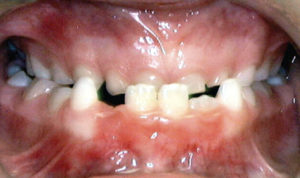Problems to Watch for in Growing Children
When a person’s teeth or jaws do not fit together properly, orthodontic treatment may be necessary to correct the problem. If left untreated, these orthodontic problems can cause speech difficulty, premature wear of the teeth and protective enamel, and even increase the chance of injury to the teeth and jaw joints.
Malocclusions (“bad bites”) like those illustrated below, may benefit from early diagnosis and referral to an orthodontic specialist for a full evaluation.
 Underbite
Underbite
An underbite is characterized by the lower jaw extending too far out, causing the lower front teeth to sit in front of the upper front teeth.
 Crossbite – Back Teeth
Crossbite – Back Teeth
This malocclusion occurs when the upper teeth sit inside the lower teeth, which may cause tooth stratification and misaligned jaw growth. In order to close the mouth, patients usually move their lower jaw forward or to the side when closing. This incorrect bite results in an improper use of the lower jaws and sometimes brings about facial asymmetry.
 Crossbite – Front Teeth
Crossbite – Front Teeth
This malocclusion occurs when the upper teeth are behind the lower teeth, which may cause tooth stratification and misaligned jaw growth. In order to close the mouth, patients usually move their lower jaw forward or to the side when closing. This incorrect bite results in an improper use of the lower jaws and sometimes brings about facial asymmetry.
 Upper Front Teeth Protrusion
Upper Front Teeth Protrusion
The appearance and function of your teeth are impacted by this type of bite. It is characterized by the upper teeth extending too far forward or the lower teeth not extending far enough forward.
 Overbite
Overbite
The upper front teeth extend too far out over the lower front teeth, sometimes causing the lower front teeth to bite into the roof of the mouth. Problems often associated with an overbite include a “gummy” smile, protruding lips and excessive incisor wear.
 Crowding
Crowding
Crowding occurs when teeth have insufficient room to erupt from the gums. It is the most common reason for braces. Not only is crowding unattractive, but it has also been linked to periodontal problems and dental decay because it is harder to clean overlapping teeth’s surfaces.
 Spacing
Spacing
Spacing problems may be caused by missing teeth, or they may only be a cosmetic or aesthetic issue. Spacing is another popular reason for braces. The opposite of crowding, spacing is most commonly caused by excessive jaw room for the size of the erupting teeth.
 Open Bite
Open Bite
Proper chewing is impacted by this type of bite, in which the upper and lower front teeth do not overlap. Openbite may cause a number of unwanted habits, such as tongue thrusting or thumb sucking. An early evaluation and intervention is essential in correcting an openbite.
 Deep Bite
Deep Bite
A deep bite is a malocclusion in which the upper front teeth excessively overlap the bottom front teeth when the back teeth are closed. This is similar to an overbite or closed bite.
Dental Midlines not Matched
Dental midlines that do not match are evident when the back bite does not fit and match appropriately. This may negatively impact jaw function and proper dental function.
Oral Habits
Poor oral habits include a wide spectrum of habits including, thumb sucking, finger sucking, blanket sucking, tongue sucking, soother/pacifier use, lip sucking, lip licking, mouth breathing, and nail-biting, among others.
In addition, if you notice any of the following in your child, check with your orthodontist:
- early or late loss of baby teeth
- difficulty in chewing or biting
- mouth breathing
jaws that shift or make sounds
- speech difficulties
- biting the cheek or the roof of the mouth
- facial imbalance
- grinding or clenching of the teeth
Final treatment decisions should be made among the parent, the child’s dentist, and the orthodontist.
Visit the American Association of Orthodontists website at aaoinfo.org.


